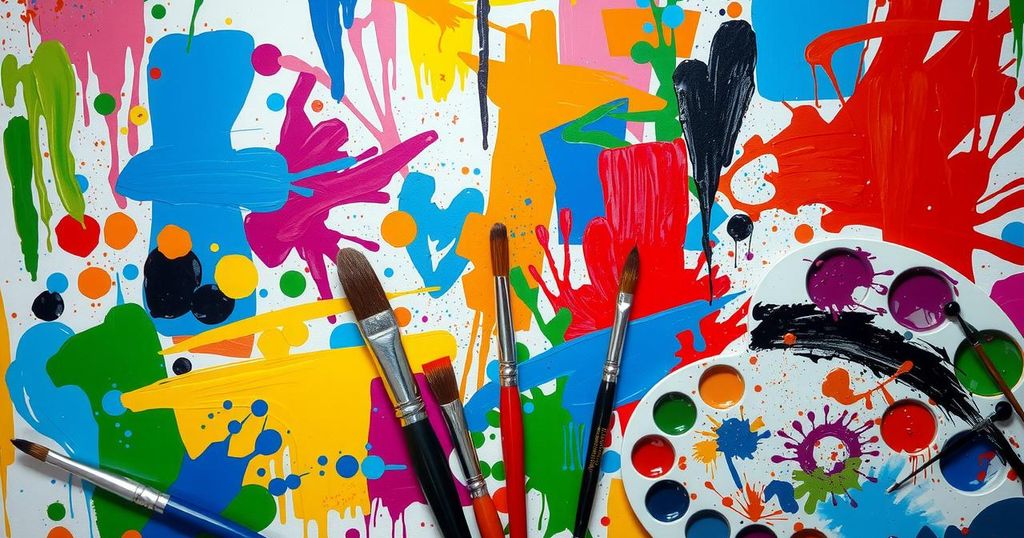Illumining the Life of Orphism: A Journey Through Color and Abstraction at the Guggenheim
The Guggenheim Museum’s “Harmony & Dissonance” exhibition explores Orphism, an art movement known for its vibrant colors and circular forms. While primarily showcasing the work of Robert and Sonia Delaunay, the exhibition also features various artists who influenced and were influenced by this ephemeral movement. It reflects both an optimistic embrace of modernity before World War I and the subsequent shadows cast by the war on artistic expression.
The Solomon R. Guggenheim Museum is hosting an exhibition titled “Harmony & Dissonance: Orphism in Paris, 1910-1930,” shedding light on Orphism—a lesser-known art movement related to cubism. Despite its brief existence and lack of a prominent manifesto, Orphism aimed to reincarnate the mundane tones of cubism into vibrant colors. Headed by prominent figures like Robert Delaunay and his wife Sonia, the movement failed to captivate mainstream attention, but its artistic legacy merits exploration.
The exhibition, organized by curators Vivien Greene and Tracey Bashkoff, features around 80 works by 26 artists, primarily from the productive years preceding World War I. This period buzzed with innovation—from lightbulbs to airplanes—prompting artists to explore how to depict speed and movement on a static canvas. The Orphists sought to transcend the static qualities of their predecessors, aiming for a new representation of modernity.
Central to the exhibition is Robert Delaunay, whose work encapsulated the movement’s ethos. His circle painting, “First Disk,” radiates a soothing harmony of colors and forms, intriguing viewers with its perpetual motion. Delaunay’s fascination with circular motifs inspired other artists, leading to various interpretations, such as planets or gears, expanding the artistic lexicon of that era.
The Guggenheim’s architectural marvel complements the show, where Wright’s rotunda evokes the circularity found in the artworks. The exhibition invites viewers to appreciate circles anew, responding to the caution once expressed by futurist R. Buckminster Fuller, who wished to move beyond them. Entering this circular visual dialogue allows for a deeper connection with modern art.
Sonia Delaunay also plays a significant role, with her influential painting “Electric Prisms” positioned as a focal point. Her engaging works merge fine art and textile design, exemplifying a multimedia approach reflective of contemporary practices. The intrinsic synergy between Robert and Sonia is palpable, blurring the lines of their individual contributions while heightening the overall experience.
While the exhibition presents American artists, their representation feels slight compared to their European counterparts. Figures like Marsden Hartley and Thomas Hart Benton contribute limited pieces, standing in stark contrast to the rich, diverse offerings from European artists like Francis Picabia and Frantisek Kupka, whose gripping color palettes and inventive techniques stand out.
Amid the vivid display, some works maintain an ambiguous relationship with Orphism. Several pieces confound expectations, adhering to a Cubist palette or retaining figurative elements. Yet, amidst these artistic explorations, Marc Chagall’s early work, and particularly “The Great Wheel,” shines brilliantly, blending narrative with a fascination for circles.
Chagall’s homage to Apollinaire captures the complexities of a world on the brink of chaos. As World War I loomed, Orphism’s celebratory tone clashed drastically with the realities of conflict. Many artists felt compelled to enlist or flee, reflecting a poignant irony as the reverberations of their joyful advancements turned dark amid wartime.
Ultimately, this struggle intertwined the lives of prominent figures like Apollinaire and Delaunay. As their art grappled with impending violence, a mysterious anecdote about Sonia’s paintings—mistaken for coded messages—illustrates the swirling perceptions these artists engaged. This exhibition provides a profound exploration of Orphism’s influence, both in artistry and the complex interplay of human experiences across time.
Orphism, largely eclipsed by Cubism, was an art movement noted for its use of vibrant colors and circular forms, aiming to energize the static nature of traditional painting. Originating in Paris in the early 20th century, it became associated with artists like Robert and Sonia Delaunay, who sought to visually capture modernity and innovation. Despite its ephemeral nature, Orphism serves as a historical reflection of artistic ambitions during an era of rapid technological change and the impending shadows of war.
The exhibition “Harmony & Dissonance” at the Guggenheim unfolds the story of Orphism, a movement that, though obscured by history, embodies a rich exploration of color and abstraction. Through the works of the Delaunays and their contemporaries, the show immerses visitors in the vibrancy and optimism of early 20th-century art. It also serves as a poignant reminder of how the march of war impacted these creative spirits, forcing a reevaluation of their joyous depictions against the backdrop of conflict.
Original Source: www.nytimes.com




Post Comment